Solar farm generates dazzling returns for local residents
- Published

Most people invest to make money, but Mark Boulton has a rather different motivation.
"I don't like the way the world is going and I've got grandchildren... In fact I've got seven of them," says the 78-year-old retiree.
A proud environmentalist deeply concerned about climate change, Mr Boulton has travelled a few miles down the road from his new eco home - built from scratch in the village of Mickleton in the Cotswolds - to admire his latest investment.
He was fascinated by the opportunity both "to get the community involved and to make a genuine difference to local wildlife. And I couldn't talk to people the way I do without [putting my money where my mouth is].
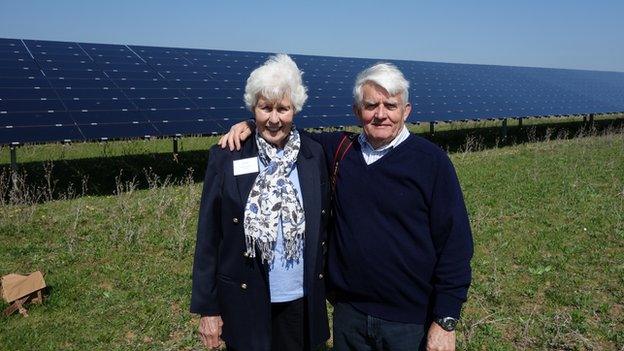
Mark Boulton convinced his wife Sonia they should invest according to their eco principles
The financial payback, he says, was "simply a bonus".
But what a bonus. Mr Boulton and his wife Sonia are earning 7% interest a year on their £6,000 investment, more than twice the best equivalent available on the High Street, currently 3%.
Last week, they received their first interest payment, and both couldn't be happier they decided to take a punt on something a little out of the ordinary.
Community power
For this investment is rather unusual - row upon row of high tech solar panels spreading out over 23 acres, quietly harvesting the sunlight on the outskirts of the picturesque village of Willersey. If you didn't know it was there, you would miss it.
The solar farm is part of the Big60Million community energy project, which has three further farms in Kent, Warwickshire and Stratford-upon-Avon, with planning permission secured for a fourth in Swindon.
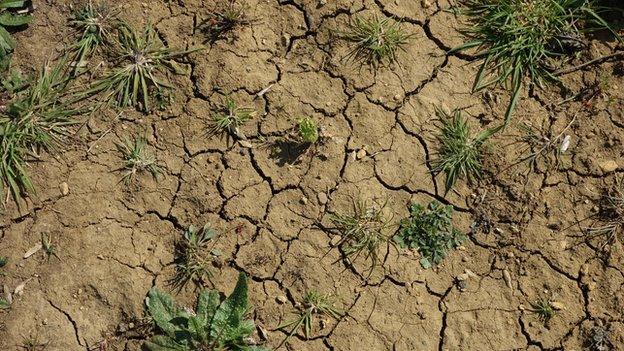
The clay-rich soil at Willersey makes growing crops particularly difficult
Working so closely with local communities, which has become central to the company's ethos, came about largely by chance. Big60 boss Toddington Harper was passionate about the benefits of solar power and felt the Willersey farm, with its poor soil unsuitable for growing crops, was the perfect site.
A very small but vocal group of locals, he says, had other ideas. Soon the Daily Mail was running a story headlined "Hands off our views", external, talking about German invasions thanks to Big60's solar partner Belectric, headquartered in Bavaria.
"We just thought 'this is not right, what we are trying to do is a good thing'," says Mr Harper. When he finally spoke with the main opponent of the farm, everything became clear.
"'What's in it for me?' was her simple message, so we took that on board and thought, 'let's make everything in it for her'."
Making money
Simplicity was key, so the company devised its five-year solar bond, each costing £60 and paying a fixed annual rate of 7%. The electricity from the 4MW farm - producing enough power in one year to meet the demands of 1,100 homes - is sold into the National Grid to generate 40% of the return, with the remaining 60% coming from government subsidies, which are guaranteed for 20 years.
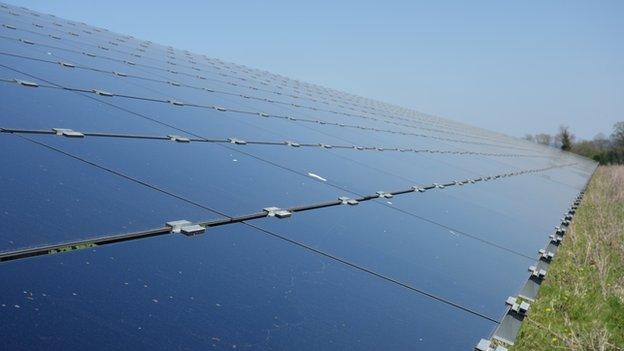
The farm uses state of the art solar panels made of glass, with no framing

The farm generates 4MW of energy which is fed directly into the National Grid
With new subsidies falling, the solar bonds launched for the latest farms offer 6% interest, with the split closer to 50/50. But Mr Harper says longer term, thanks in large part to the falling cost of solar panels, the business model will not rely on government support.
"I look forward to the day we have no subsidies," he says. "Within five years I think we can work without them." Much will depend on the cost of panels.
The Willersey bond offer raised £4m in two months from hundreds of individual investors, with 20% being bought by local residents. The rest came on the back of adverts in the national press.
Many were not interested in the environmental benefits of the farm, but simply wanted a good cash return. As investor Mike Scowan from Towcester near Northampton says: "Where else are you going to get 7%? You won't get it at the bank or building society and the returns on ISAs are pretty miserable".
He's so pleased with his solar bond he's thinking about investing more next time round.
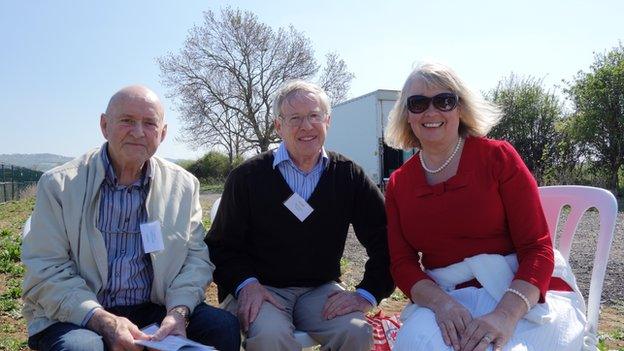
Many investors were more interested in the financial return than the environmental benefits
Seasoned private investor Dr Geoffrey Taylor from Cheltenham is equally delighted. He was attracted both by the interest rate and by the fact the bond was underpinned by a guaranteed government subsidy, not to mention a share of the farm's assets should the company get into trouble. To him, the solar bond is just another investment - so much so in fact that last week's interest payment came as something of a surprise. "I had completely forgotten about it," he says.
Boosting bees
But Big60Million is about much more than money. Only 5% of Willersey solar farm's ground is covered by the infrastructure needed to support the solar panels, which means the vast majority of the land is given over to encourage biodiversity. Conservation experts Flowerscapes were brought in to advise on plant and wildlife in an attempt to make better use of the low grade soil, with more than £10,000 spent on wildflowers alone, according to Mr Harper.
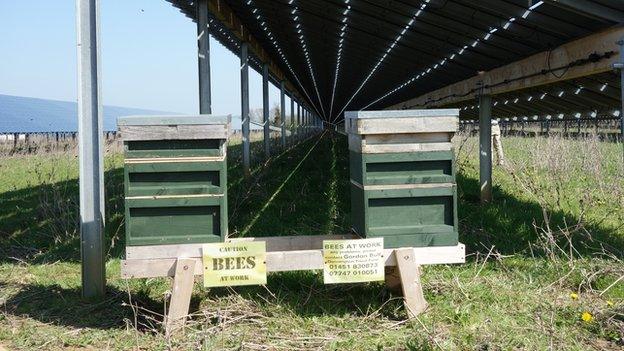
Beehives have been brought in as part of wider push to encourage biodiversity on the farm
Local beekeepers built hives to boost dwindling bee populations, while various bird and bat boxes, as well as habitats for insects and reptiles, have been placed across the farm to give wildlife the chance to flourish. Local schools also visit the farm so children can learn about the benefits of clean energy.
And this is just beginning. Big60 plans to install energy storage batteries on the site at the beginning of next year, the next step towards making the local community energy independent. Currently, all the power generated by the farm is sold to the grid, but there is no reason why in the future the electricity cannot go directly into local homes and businesses.
Infrastructure is a major barrier, but "within the next five years I think we'll work out a way to do it", says Mr Harper. This would probably involve doing a deal with the local network provider.
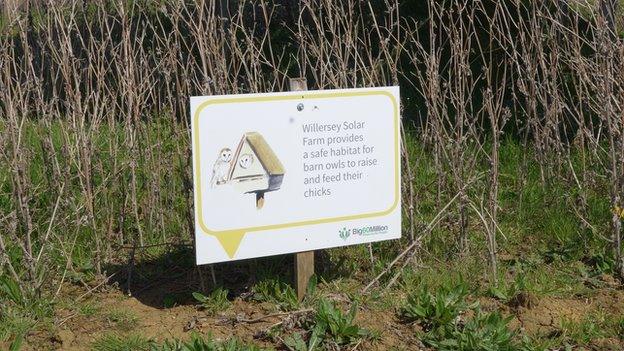
Big60 wants wildlife to prosper by making use of the farmland under and around the solar panels
In the meantime, the company has big plans to build more solar farms. "Our vision is that each town and village in the country should have something similar [to Willersey]," Mr Harper says.
In fact, Big60Million is at the forefront of a fundamental shift in the way that energy is generated and distributed in the UK. Indeed the government estimates there are already 5,000 community energy projects in the country, which could generate up to 15% of the country's total renewable electricity generation by 2020. The potential is huge - in Germany, community energy already makes up more than 40% of renewable output.
Back in Willersey, the investors are more preoccupied with enjoying a perfect spring day.
Gazing out over the glistening farm, soaking up the blazing sun and breathing clean fresh air, peaceful but for the quiet hum of bees buzzing and birds chirping, Dr Taylor's wife Patty has seen the future, and she likes it.
"It makes you feel very good," she says.
What was meant to be nothing more than a good investment opportunity has turned into so much more.